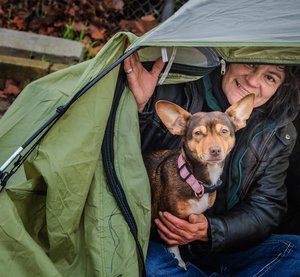Collectively, we know them as “the homeless.” Most of us never speak to them and avoid making eye contact. -Cynthia Hubert, Sacramento Bee
The looking-glass self is a social psychological concept that states a person’s self grows out of society’s interpersonal interactions and the perceptions of others. In other words, how we see ourselves does not come from who we really are, but rather from how we believe others see us.
For me, photography is an instrument of change. For example, I firmly believe that images have the power to alter the viewer’s perception of those who are homeless. More recently, I have reached the conclusion that strong images can also change how the homeless see themselves.
On the second Saturday of the month you will find me at Loaves and Fishes shooting homeless people and their pets. This is when the University of California Davis Mercer Veterinary Clinic provides the pets of homeless individuals with basic veterinary care.
I try to capture in “family portraits”, the comfort and joy that dogs bring to their homeless owners. After processing the images, the pet owners are provided with the pictures I have taken. For many owners one picture is a more than a thousand words. A single picture is also a looking-glass for owners to see the bonds of love and companionship that exist between themselves and their pets.
-Gale















